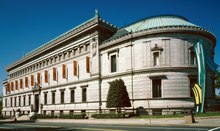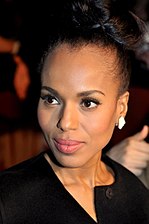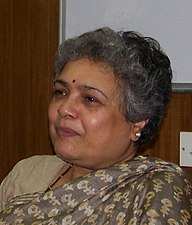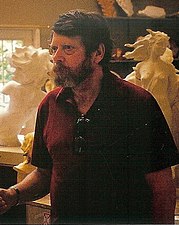 Corcoran School of the Arts and Design (2019) Corcoran School of the Arts and Design (2019) | |
| Other name | Corcoran School |
|---|---|
| Type | Private |
| Established | 1878; 147 years ago (1878) |
| Parent institution | George Washington University |
| Director | Lauren Onkey |
| Location | Washington, D.C., U.S. |
| Campus | Urban—Foggy Bottom |
| Website | corcoran.gwu.edu |
The Corcoran School of the Arts and Design (known as the Corcoran School or CSAD) is the professional art school of the George Washington University, in Washington, D.C. Founded in 1878, the school is housed in the Corcoran Gallery of Art, the oldest private cultural institution in Washington, located on The Ellipse, facing the White House. The Corcoran School is part of GW's Columbian College of Arts and Sciences and was formerly an independent college, until 2014.
History
19th century
William Wilson Corcoran founded the Corcoran Gallery of Art in 1869. Construction had begun at 17th Street and Pennsylvania Avenue in 1859, but shortly after the exterior work was completed, the Quartermaster General's corps of the Union Army occupied the building, setting up offices for the duration of the Civil War.
Work resumed immediately after the conclusion of the war, with Corcoran formally founding his gallery as an institution in 1869. The first special event held that year was a fundraiser for the completion of the Washington Monument. Corcoran's gallery welcomed its first visitors in 1887, which included art students, who were eager to sketch and paint copies of the collection's famous works.
In 1877, the painter E.F. Andrews (1835–1915) started offering the visiting students and artists formal instruction in two dimensional media for no cost. In 1878, William Wilson Corcoran donated additional funding to be used to establish a school to be associated with the gallery. After Corcoran's 1888 death, a small building was built behind the gallery in 1889 for the purpose of the gallery's burgeoning identity as a place for education in the arts. In 1890 the school officially opened as the Corcoran School of Art.

By the 1890s, both the gallery and the school programs had outgrown their respective spaces. A new, larger building designed by Ernest Flagg was constructed in 1897 at New York Avenue and 17th Street, with the basement level dedicated to workshops and studios for the students, and an upper two floors given over to large gallery spaces. From 1897 to the 1930s, the school continued in a modest existence for art students interested in a museum school. By the 1930s, the school had begun expanding: commercial art classes, scholarships, children's courses, the library, ceramics facilities and courses, weekend classes and summer opportunities were added.
20th century
Successful accreditation in the National Association of Schools of Art (NASAD) was achieved in the mid-1970s, with the first BFA degree bestowed in 1978. During this time artists that taught at the school included Gene Davis, Thomas Downing, Sam Gilliam, Anne Truitt, Ed McGowin, William Christenberry, Percy Martin and Paul Reed.
Starting in the 1970s, the College utilized three facilities: the historic Flagg Building housed fine art facilities, the fine art photography and photojournalism facilities. A second building, in Georgetown, housing the Digital Media, Graphic Design, and New Media Photojournalism programs, as well as many fine art offerings in painting and drawing. Additional programs were offered through the Smithsonian's S. Dillon Ripley Center. In 1985, the college was formally accredited by the Middle States Commission on Higher Education.

In 1999, the school was formally renamed as The Corcoran College of Art and Design and worked to further its reputation as the singular four-year arts and design institution in Washington, D.C. As a museum school, students and faculty benefited from co-existing with the Corcoran Gallery with its more than 17,000 works and objects. In the later years of the gallery, a dedicated space known as Studio 31 displayed student art, in addition to special biennials and exhibitions of student work on display throughout the year. The annual NEXT show, staged at the end of each academic year, displayed student senior thesis projects to the greater DC community.
21st century
In 2014, a DC Superior Court-approved agreement saw the closure of the Gallery and the passing of most of the original collection into the public National Gallery of Art. The Flagg Building and college operations were handed over to the George Washington University, which today operates the Corcoran School of the Arts and Design within the Columbian College of Arts and Sciences.
In September 2014 the D.C. arts community held a funeral for the closing of the Corcoran School of Art.
Academics
The Corcoran School of the Arts and Design currently offers the degrees of Bachelor of Fine Arts (in Fine Art, Fine Art Photography, Photojournalism, Graphic Design, Interaction Design, and Interior Architecture); Bachelor of Arts (in Fine Art, Art History, Theatre & Dance, and Music); Master of Fine Arts (in Fine Arts, Social Practice, Interior Architecture, Classical Acting, and Production Design); Master of Arts (in Art History, New Media Photojournalism, Museum Studies, Interaction Design, Exhibition Design, and—in partnership with the Smithsonian Associates—Decorative Arts and Design History); graduate certificates in Museum Collections Management and Care, and Museum Studies; and a joint BA/MA program. After merging with George Washington University, the Corcoran School of the Arts and Design discontinued their Interior Design and Art Education programs.
Students are exposed to internships with organizations including National Geographic Magazine, embassies, and White House news photographers; summer study abroad trips in Italy, Greece, and India; and visiting artists such as Annie Leibovitz, Shepard Fairey, Maya Lin, Abelardo Morell, and William Pope. For a period of time in the spring, senior students' works for their senior theses are exhibited within the museum, giving the students experience in gallery openings as well as public exposure to their work.
The College's Continuing Education Program, which offers non-credit classes to teens and adults, draws hundreds of participants every year.
Notable alumni
See also: Category:Corcoran School of the Arts and Design alumni- Notable Alumni of the Corcoran School
-
 Tim Gunn, Project Runway star, Fashion Chair at Parsons School of Design
Tim Gunn, Project Runway star, Fashion Chair at Parsons School of Design
-
 Jared Leto, Golden Globe and Oscar-winning actor
Jared Leto, Golden Globe and Oscar-winning actor
-
 Daniel H. Weiss, President & CEO the Metropolitan Museum of Art
Daniel H. Weiss, President & CEO the Metropolitan Museum of Art
-
 David Lynch, Palme d'Or-winning and Emmy Award-nominated actor
David Lynch, Palme d'Or-winning and Emmy Award-nominated actor
-
 Kerry Washington, Time 100 and Emmy Award-winning actress
Kerry Washington, Time 100 and Emmy Award-winning actress
-
 Duff Goldman, star of Ace of Cakes
Duff Goldman, star of Ace of Cakes
-
 Dariush Kashani, Tony Award-winning actor
Dariush Kashani, Tony Award-winning actor
-
 Mrinal Pande, Chair of Prasar Bharati, India's largest public broadcaster
Mrinal Pande, Chair of Prasar Bharati, India's largest public broadcaster
-
 Frederick Hart, National Medal of Arts-winning sculptor, U.S. Fine Arts Commission member
Frederick Hart, National Medal of Arts-winning sculptor, U.S. Fine Arts Commission member
Notable alumni of the Corcoran School of the Arts and Design, include:
- Ernest Bairstow – English born American sculptor known for carving the Gettysburg Address on the Lincoln Memorial
- Aurelius Battaglia – former Disney artist and children's book illustrator
- Gladys Edgerly Bates – American sculptor
- Ned Bittinger – American portrait painter and illustrator
- Jared Leto – American musician and actor
- Tim Gunn – American fashion expert and television personality
- David Lynch – American filmmaker, painter, composer, video artist and performance artist
- Tara Donovan – American installation artist
- Bjorn Peter Egeli – American-Norwegian portrait painter
- Eugene Goossen – art critic and historian
- Bernard O. Gruenke – American stained glass artist
- Edwin Finckel – composer
- Frederick Hart – American sculptor
- Francine Haskins – multi-media textile artist and book illustrator
- Nan Hoover – American photographer, video artist, and performance artist
- Nadezhda Kouteva – Bulgarian artist
- Eugene J. Martin – American visual artist
- Madiha Omar – Iraqi painter
- Bruce Jurgens – American artist and producer
- Jody Mussoff – American artist
- Sabrina Raaf – American artist
- Sonya Rapoport – American artist
- Ian Svenonius – American musician and author
- Salarrué – Salvadoran writer, poet, and painter
- Duff Goldman – American pastry chef and television personality
- Kim Kirkpatrick – photographer
- Pacita Abad – painter
- Ruth Chew – author
- Spencer Baird Nichols – American painter, illustrator and muralist
- Josephine Lutz Rollins – painter and watercolor artist
- Kathryn Zaremba – former Full House and Toothless star
- Javier Cabada – Spanish-American abstract artist
- Thomas Hart Benton – American regionalist painter
- Morris Cafritz – Washington, D.C. real estate developer and philanthropist
- Mrinal Pande – Indian journalist and author
- Kerry Washington – actress and producer, B.A. '98
- Daniel H. Weiss – president and chief operating officer of Metropolitan Museum of Art, B.A. '79
- Dariush Kashani – American film, stage and television actor
- Percy Martin – American printmaker and art teacher
- Judy Byron – contemporary American artist
- Gregory Coates – American artist
Notable faculty
See also: Category:Corcoran School of the Arts and Design facultyReferences
- Peggy McGlone, University names first director of Corcoran School of the Arts and Design, Washington Post (August 4, 2015).
- Colleen Murphy & Allison Kowalski, Columbian College to absorb Corcoran school, GW Hatchet (June 12, 2014).
- David Montgomery, Corcoran Gallery of Art and College to split apart, partnering with National Gallery, GWU, Washington Post (February 19, 2014).
- ^ "History of the Corcoran: Founding of the Corcoran School of Art". corcoran.org. Corcoran Gallery of Art. Archived from the original on 2007-06-07. Retrieved August 13, 2020.
- Cohen, Jean Lawlor; Cohen, Jean Lawlor (2015-06-26). "When the Washington Color School earned its stripes on the national stage". The Washington Post. ISSN 0190-8286. Retrieved 2017-03-02.
- "Beloved Sculptor Anne Truitt Gets Her Due". PBS NewsHour. October 27, 2009. Retrieved 2017-03-02 – via PBS.org.
- "Percy Martin". americanart.si.edu. Smithsonian Institution. Retrieved August 13, 2020.
- Applewhite, E. J. (1993). Washington Itself: An Informal Guide to the Capital of the United States. Rowman & Littlefield. p. 123.
- Goukassian, Elena (2014-09-29). "In a Pseudo-Funeral, Mourners Grieve the Closing of the Corcoran Gallery of Art". Washington City Paper. Retrieved 2024-08-21.
- Dobryznski, Judith H. "Eugene Goossen, 76, Art Critic", The New York Times, July 17, 1997. Accessed July 25, 2010.
- Craftsmen of Wisconsin by Bertha Kitchell Whyte, 1971, Western Publishing Company, Library of Congress 79-150495
- Edwin Finckel Archived 2011-01-08 at the Wayback Machine, artistled.com, accessed 1 January 2011
- "Broken Arrow Performing Arts Center Broken Arrow, Oklahoma". www.brokenarrowpac.com. Archived from the original on 2019-04-06. Retrieved 2016-03-15.
- "Thomas Hart Benton: Murals in the Missouri State Capitol". benton.truman.edu. Archived from the original on 2015-02-21. Retrieved 2017-03-02.
- Solomon, Burt (2004). The Washington Century: Three Families and the Shaping of the Nation's Capital. William Morrow. pp. 1–2. ISBN 978-0-06-621372-9.
- "Word power "Harmony Magazine". www.harmonyindia.org.
- "World Without End". Washington City Paper. 16 May 2003. Retrieved 2019-01-30.
External links
| Colleges and universities in the District of Columbia | |
|---|---|
| Research universities | |
| Master’s colleges and universities | |
| Specialized colleges | |
| Former institutions |
|
| Northeastern United States art colleges | |
|---|---|
| Active | |
| Closed | |
38°53′44.8″N 77°2′24.8″W / 38.895778°N 77.040222°W / 38.895778; -77.040222
Categories:- 1890 establishments in Washington, D.C.
- Art schools in Washington, D.C.
- Beaux-Arts architecture in Washington, D.C.
- Colleges and Schools of The George Washington University
- Columbian College of Arts and Sciences
- Corcoran family
- Private universities and colleges in Washington, D.C.
- Universities and colleges established in 1890

